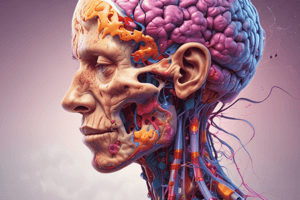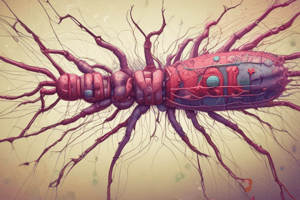Podcast
Questions and Answers
What is the function of keratin in the skin?
What is the function of keratin in the skin?
- Waterproofs the skin and protects from microbial invasion (correct)
- Aids in the production of sebum and lysozyme
- Sloughs off dead cells from the epidermis
- Provides sensation and blood supply to the skin
Which layer of the skin contains nerves, blood vessels, and lymphatic vessels?
Which layer of the skin contains nerves, blood vessels, and lymphatic vessels?
- Dermis (correct)
- Subcutaneous layer
- Epidermis
- Stratum corneum
What is the primary cause of acne?
What is the primary cause of acne?
- Increased sebum production and blockage of follicle ducts (correct)
- Allergic reaction to environmental factors
- Excessive keratin production in the epidermis
- Deficiency of normal flora in the skin
Which of the following skin diseases is caused by Staphylococcus bacteria?
Which of the following skin diseases is caused by Staphylococcus bacteria?
What can trauma to the skin, such as cuts or burns, lead to?
What can trauma to the skin, such as cuts or burns, lead to?
What is the function of the subcutaneous layer of the skin?
What is the function of the subcutaneous layer of the skin?
What is the primary prevention for cold sores caused by Herpes simplex virus (HSV)?
What is the primary prevention for cold sores caused by Herpes simplex virus (HSV)?
What is the cause of smallpox, which was eradicated through vaccination in 1977?
What is the cause of smallpox, which was eradicated through vaccination in 1977?
Which vaccine is highly effective in preventing Rubella, also known as German measles?
Which vaccine is highly effective in preventing Rubella, also known as German measles?
What is the main mode of transmission of warts caused by papillomaviruses?
What is the main mode of transmission of warts caused by papillomaviruses?
What is the primary cause of conjunctivitis, also known as 'pink eye'?
What is the primary cause of conjunctivitis, also known as 'pink eye'?
What is the main mode of transmission of Leishmaniasis?
What is the main mode of transmission of Leishmaniasis?
What are potential complications of otitis media?
What are potential complications of otitis media?
Which bacteria is NOT mentioned as a cause of otitis media?
Which bacteria is NOT mentioned as a cause of otitis media?
What is the CNS composed of?
What is the CNS composed of?
How can pathogens access the CNS?
How can pathogens access the CNS?
What are examples of bacterial diseases of the nervous system?
What are examples of bacterial diseases of the nervous system?
How is bacterial meningitis mostly transmitted?
How is bacterial meningitis mostly transmitted?
What causes the development of acne?
What causes the development of acne?
How is impetigo caused?
How is impetigo caused?
What virus causes chickenpox?
What virus causes chickenpox?
How is cat scratch disease transmitted?
How is cat scratch disease transmitted?
What causes gas gangrene?
What causes gas gangrene?
What is the cause of scalded skin syndrome?
What is the cause of scalded skin syndrome?
Which disease is transmitted through the fecal-oral route?
Which disease is transmitted through the fecal-oral route?
Which disease is diagnosed postmortem by detecting Negri bodies in the brain?
Which disease is diagnosed postmortem by detecting Negri bodies in the brain?
Which disease can be prevented through vaccination?
Which disease can be prevented through vaccination?
Which disease is caused by an abnormal form of prion?
Which disease is caused by an abnormal form of prion?
Which disease is transmitted by the Tse Tse fly in equatorial Africa?
Which disease is transmitted by the Tse Tse fly in equatorial Africa?
Which disease prevents muscle contraction and leads to double vision and difficulty swallowing?
Which disease prevents muscle contraction and leads to double vision and difficulty swallowing?
Match the skin layer with its primary function:
Match the skin layer with its primary function:
Match the skin disease with its description:
Match the skin disease with its description:
Match the skin disease with its potential prevention or treatment method:
Match the skin disease with its potential prevention or treatment method:
Match the skin disease with its potential complications or severity:
Match the skin disease with its potential complications or severity:
Match the following diseases with their causative agents:
Match the following diseases with their causative agents:
Match the following diseases with their mode of transmission:
Match the following diseases with their mode of transmission:
Match the following diseases with their primary prevention method:
Match the following diseases with their primary prevention method:
Match the following diseases with their potential treatments:
Match the following diseases with their potential treatments:
Match the following skin infections with their causative agents:
Match the following skin infections with their causative agents:
Match the following skin infections with their symptoms:
Match the following skin infections with their symptoms:
Match the following bacteria with their associated diseases of the nervous system:
Match the following bacteria with their associated diseases of the nervous system:
Match the following symptoms with the types of meningitis:
Match the following symptoms with the types of meningitis:
Match the following nervous system diseases with their causes:
Match the following nervous system diseases with their causes:
Match the following complications with their associated diseases:
Match the following complications with their associated diseases:
Match the skin or wound disease with its causative agent:
Match the skin or wound disease with its causative agent:
Match the skin or wound disease with its description:
Match the skin or wound disease with its description:
Match the skin or wound disease with its causative agent:
Match the skin or wound disease with its causative agent:
Match the description with the skin or wound disease:
Match the description with the skin or wound disease:
Match the infectious disease with its primary mode of transmission:
Match the infectious disease with its primary mode of transmission:
Match the infectious disease with its characteristic symptoms:
Match the infectious disease with its characteristic symptoms:
Match the infectious disease with its preventable method:
Match the infectious disease with its preventable method:
Match the infectious disease with its diagnosis method:
Match the infectious disease with its diagnosis method:
Match the disease with its unique feature:
Match the disease with its unique feature:
Match the infectious disease with its potential complications:
Match the infectious disease with its potential complications:
Study Notes
Infectious Diseases Affecting the Nervous System
- Variant Creutzfeldt-Jakob Disease (vCJD) symptoms include insomnia, weight loss, and memory failure, with progressive muscle control deterioration.
- vCJD is caused by an abnormal form of prion that can remain dormant for many years.
- Rabies is transmitted through contact with infected animal body fluids, with an incubation period of 1-2 months. It replicates in muscle cells then moves into neurons.
- Rabies symptoms include anxiety, impaired swallowing, and can lead to coma and death, with two main forms: furious rabies and dumb rabies.
- Poliovirus is transmitted through the fecal-oral route, with symptoms ranging from asymptomatic to paralysis, and it can lead to muscle atrophy and deformities.
- Tetanus symptoms include muscle contraction inhibition and rigid “spastic” paralysis, with a unique tennis racket morphology of Clostridium tetani.
- Botulism has three types and prevents muscle contraction, leading to double vision, difficulty swallowing, and descending muscular paralysis.
- African Trypanosomiasis, or sleeping sickness, is caused by two protists and is transmitted by the Tse Tse fly in equatorial Africa, leading to fever, malaise, and eventually coma and death.
- Primary Amebic Meningoencephalopathy is caused by Acanthamoeba and Naegleria, entering the host through skin abrasions or contaminated water inhalation.
- Diagnosis of vCJD is based on characteristic signs and symptoms, while rabies is diagnosed postmortem by detecting Negri bodies in the brain.
- There is no treatment for vCJD, rabies, and primary amebic meningoencephalopathy, but polio is preventable through vaccination.
- Prevention of these diseases includes avoiding prion-contaminated meat, immunizing pets and people against rabies, and controlling Tse Tse flies to decrease African Trypanosomiasis.
Infectious Diseases Affecting the Nervous System
- Variant Creutzfeldt-Jakob Disease (vCJD) symptoms include insomnia, weight loss, and memory failure, with progressive muscle control deterioration.
- vCJD is caused by an abnormal form of prion that can remain dormant for many years.
- Rabies is transmitted through contact with infected animal body fluids, with an incubation period of 1-2 months. It replicates in muscle cells then moves into neurons.
- Rabies symptoms include anxiety, impaired swallowing, and can lead to coma and death, with two main forms: furious rabies and dumb rabies.
- Poliovirus is transmitted through the fecal-oral route, with symptoms ranging from asymptomatic to paralysis, and it can lead to muscle atrophy and deformities.
- Tetanus symptoms include muscle contraction inhibition and rigid “spastic” paralysis, with a unique tennis racket morphology of Clostridium tetani.
- Botulism has three types and prevents muscle contraction, leading to double vision, difficulty swallowing, and descending muscular paralysis.
- African Trypanosomiasis, or sleeping sickness, is caused by two protists and is transmitted by the Tse Tse fly in equatorial Africa, leading to fever, malaise, and eventually coma and death.
- Primary Amebic Meningoencephalopathy is caused by Acanthamoeba and Naegleria, entering the host through skin abrasions or contaminated water inhalation.
- Diagnosis of vCJD is based on characteristic signs and symptoms, while rabies is diagnosed postmortem by detecting Negri bodies in the brain.
- There is no treatment for vCJD, rabies, and primary amebic meningoencephalopathy, but polio is preventable through vaccination.
- Prevention of these diseases includes avoiding prion-contaminated meat, immunizing pets and people against rabies, and controlling Tse Tse flies to decrease African Trypanosomiasis.
Studying That Suits You
Use AI to generate personalized quizzes and flashcards to suit your learning preferences.
Related Documents
Description
Test your knowledge of infectious diseases affecting the nervous system with this quiz. Explore symptoms, transmission, and prevention methods for diseases like vCJD, rabies, poliovirus, tetanus, botulism, African trypanosomiasis, and more.




